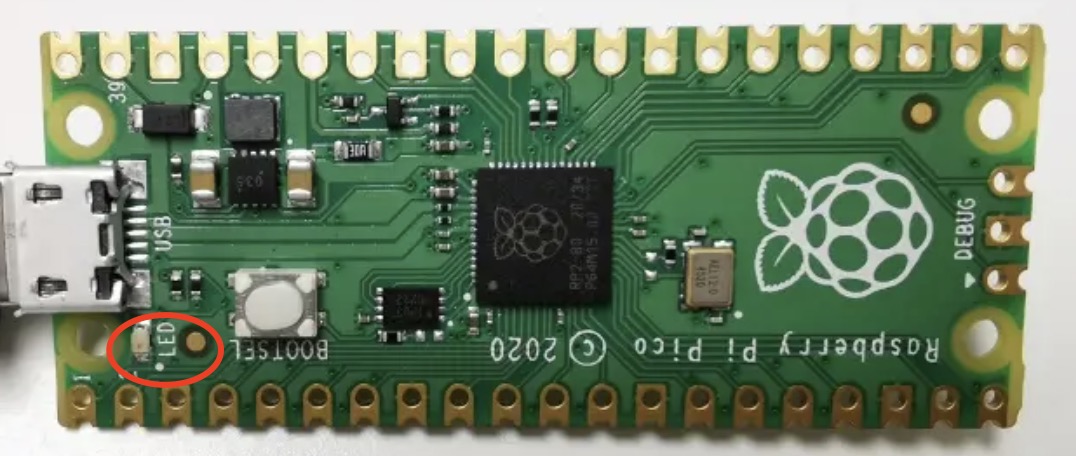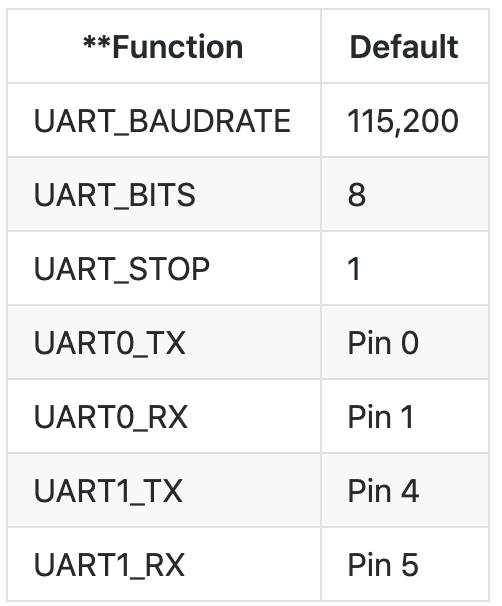I/O使用
操作I/O是玩硬件的基础,我们可以用来控制开关量的设备,例如点灯、蜂鸣器、按键等等。详细的硬件的设计这里并不做解释,课参考单片机的学习资料,主要介绍程序撰写。
我们以点灯为例子看一下GPIO的使用,在核心板上就一偶一个LED:
在开始安装环境的时候阿chai提供的程序就是点灯的程序,接下来我们看看具体是如何操作的。
MicroPython版本
MicroPython中提供了点灯的接口,我们看一下程序:
# 调用pico的GPIO模块
from machine import Pin
# 设置GPIO的模式,案例中为输出模式
led = Pin(25, Pin.OUT)
# 输出高低电平
led.value(1)
led.value(0)这个时候我们可以看到小灯是亮一下灭了。
C/C++版本
以下为运行程序:
#include "pico/stdlib.h" //头文件
int main() {
const uint LED_PIN = 25; //设置IO口
gpio_init(LED_PIN); //初始化IO
gpio_set_dir(LED_PIN, GPIO_OUT); //设置IO口的模式
while (true) {
gpio_put(LED_PIN, 1); //输出高电平
sleep_ms(250); //延时250ms
gpio_put(LED_PIN, 0); //输出低电平
sleep_ms(250); //延时250ms
}
}CMakeLists.txt:
add_executable(blink
blink.c
)
# Pull in our pico_stdlib which pulls in commonly used features
target_link_libraries(blink pico_stdlib)
# create map/bin/hex file etc.
pico_add_extra_outputs(blink)
# add url via pico_set_program_url
example_auto_set_url(blink)UART
USART是一个全双工通用同步/异步串行收发模块,该接口是一个高度灵活的串行通信设备。USART收发模块一般分为三大部分:时钟发生器、数据发送器和接收器。控制寄存器为所有的模块共享。
MicroPython
from machine import Pin
from rp2 import PIO, StateMachine, asm_pio
UART_BAUD = 115200
PIN_BASE = 10
NUM_UARTS = 8
@asm_pio(sideset_init=PIO.OUT_HIGH, out_init=PIO.OUT_HIGH, out_shiftdir=PIO.SHIFT_RIGHT)
def uart_tx():
# Block with TX deasserted until data available
pull()
# Initialise bit counter, assert start bit for 8 cycles
set(x, 7) .side(0) [7]
# Shift out 8 data bits, 8 execution cycles per bit
label("bitloop")
out(pins, 1) [6]
jmp(x_dec, "bitloop")
# Assert stop bit for 8 cycles total (incl 1 for pull())
nop() .side(1) [6]
# Now we add 8 UART TXs, on pins 10 to 17. Use the same baud rate for all of them.
uarts = []
for i in range(NUM_UARTS):
sm = StateMachine(
i, uart_tx, freq=8 * UART_BAUD, sideset_base=Pin(PIN_BASE + i), out_base=Pin(PIN_BASE + i)
)
sm.active(1)
uarts.append(sm)
# We can print characters from each UART by pushing them to the TX FIFO
def pio_uart_print(sm, s):
for c in s:
sm.put(ord(c))
# Print a different message from each UART
for i, u in enumerate(uarts):
pio_uart_print(u, "Hello from UART {}!\n".format(i))C/C++
以下为测试demo:
#include "pico/stdlib.h"
#include "hardware/uart.h"
#include "hardware/irq.h"
/// \tag::uart_advanced[]
#define UART_ID uart0
#define BAUD_RATE 115200
#define DATA_BITS 8
#define STOP_BITS 1
#define PARITY UART_PARITY_NONE
// We are using pins 0 and 1, but see the GPIO function select table in the
// datasheet for information on which other pins can be used.
#define UART_TX_PIN 0
#define UART_RX_PIN 1
static int chars_rxed = 0;
// RX interrupt handler
void on_uart_rx() {
while (uart_is_readable(UART_ID)) {
uint8_t ch = uart_getc(UART_ID);
// Can we send it back?
if (uart_is_writable(UART_ID)) {
// Change it slightly first!
ch++;
uart_putc(UART_ID, ch);
}
chars_rxed++;
}
}
int main() {
// Set up our UART with a basic baud rate.
uart_init(UART_ID, 2400);
// Set the TX and RX pins by using the function select on the GPIO
// Set datasheet for more information on function select
gpio_set_function(UART_TX_PIN, GPIO_FUNC_UART);
gpio_set_function(UART_RX_PIN, GPIO_FUNC_UART);
// Actually, we want a different speed
// The call will return the actual baud rate selected, which will be as close as
// possible to that requested
int actual = uart_set_baudrate(UART_ID, BAUD_RATE);
// Set UART flow control CTS/RTS, we don't want these, so turn them off
uart_set_hw_flow(UART_ID, false, false);
// Set our data format
uart_set_format(UART_ID, DATA_BITS, STOP_BITS, PARITY);
// Turn off FIFO's - we want to do this character by character
uart_set_fifo_enabled(UART_ID, false);
// Set up a RX interrupt
// We need to set up the handler first
// Select correct interrupt for the UART we are using
int UART_IRQ = UART_ID == uart0 ? UART0_IRQ : UART1_IRQ;
// And set up and enable the interrupt handlers
irq_set_exclusive_handler(UART_IRQ, on_uart_rx);
irq_set_enabled(UART_IRQ, true);
// Now enable the UART to send interrupts - RX only
uart_set_irq_enables(UART_ID, true, false);
// OK, all set up.
// Lets send a basic string out, and then run a loop and wait for RX interrupts
// The handler will count them, but also reflect the incoming data back with a slight change!
uart_puts(UART_ID, "\nHello, uart interrupts\n");
while (1)
tight_loop_contents();
}CMakeLists.txt:
add_executable(uart_advanced
uart_advanced.c
)
# Pull in our pico_stdlib which pulls in commonly used features
target_link_libraries(uart_advanced pico_stdlib hardware_uart)
# create map/bin/hex file etc.
pico_add_extra_outputs(uart_advanced)
# add url via pico_set_program_url
example_auto_set_url(uart_advanced)中断、定时器
中断和定时器是CPU必不可少的部分,详细的介绍这里不过多赘述,我们直接看一下代码。定时器的代码主要结合C去讲解,这样比较清楚。
MicroPython
中断
from machine import Pin
p2 = Pin(2, Pin.IN, Pin.PULL_UP)
p2.irq(lambda pin: print("IRQ with flags:", pin.irq().flags()),
Pin.IRQ_FALLING)C/C++
定时器功能也很基础,而且只有一个,主要功能如下:
- 64位计数器 (频率固定1MHz,所以要好几千年才能溢出)
- 4个闹钟 (闹钟是只匹配低32B,最大间隔4295秒)
- 寄存器自带映射,所以多个处理器同时访问也不用考虑竞争问题(无需考虑竞争问题)
其中ALARM功能只会发起一次中断,中断发生后就会清除ARMED位,所有函数都有他的毫秒版本和微秒版本。
#include <stdio.h>
#include "pico/stdlib.h"
#include "pico/util/queue.h"
bool timer_callback(repeating_timer_t *rt);
queue_t sample_fifo;
// using struct as an example, but primitive types can be used too
typedef struct element {
uint value;
} element_t;
const int FIFO_LENGTH = 32;
int main() {
stdio_init_all();
int hz = 25;
queue_init(&sample_fifo, sizeof(element_t), FIFO_LENGTH);
repeating_timer_t timer;
// negative timeout means exact delay (rather than delay between callbacks)
if (!add_repeating_timer_us(-1000000 / hz, timer_callback, NULL, &timer)) {
printf("Failed to add timer\n");
return 1;
}
// read some blocking
for (int i = 0; i < 10; i++) {
element_t element;
queue_remove_blocking(&sample_fifo, &element);
printf("Got %d: %d\n", i, element.value);
}
// now retrieve all that are available periodically (simulate polling)
for (int i = 0; i < 10; i++) {
int count = queue_get_level(&sample_fifo);
if (count) {
printf("Getting %d, %d:\n", i, count);
for (; count > 0; count--) {
element_t element;
queue_remove_blocking(&sample_fifo, &element);
printf(" got %d\n", element.value);
}
}
sleep_us(5000000 / hz); // sleep for 5 times the sampling period
}
cancel_repeating_timer(&timer);
// drain any remaining
element_t element;
while (queue_try_remove(&sample_fifo, &element)) {
printf("Got remaining %d\n", element.value);
}
queue_free(&sample_fifo);
printf("Done\n");
}
bool timer_callback(repeating_timer_t *rt) {
static int v = 100;
element_t element = {
.value = v
};
v += 100;
if (!queue_try_add(&sample_fifo, &element)) {
printf("FIFO was full\n");
}
return true; // keep repeating
}
CMakeLists.txt:
if (NOT PICO_TIME_NO_ALARM_SUPPORT)
add_executable(periodic_sampler
periodic_sampler.c
)
# Pull in our (to be renamed) simple get you started dependencies
target_link_libraries(periodic_sampler pico_stdlib)
# create map/bin/hex file etc.
pico_add_extra_outputs(periodic_sampler)
# add url via pico_set_program_url
example_auto_set_url(periodic_sampler)
endif()lowlevel:
#include <stdio.h>
#include "pico/stdlib.h"
#include "hardware/timer.h"
#include "hardware/irq.h"
/// \tag::get_time[]
// Simplest form of getting 64 bit time from the timer.
// It isn't safe when called from 2 cores because of the latching
// so isn't implemented this way in the sdk
static uint64_t get_time(void) {
// Reading low latches the high value
uint32_t lo = timer_hw->timelr;
uint32_t hi = timer_hw->timehr;
return ((uint64_t) hi << 32u) | lo;
}
/// \end::get_time[]
/// \tag::alarm_standalone[]
// Use alarm 0
#define ALARM_NUM 0
#define ALARM_IRQ TIMER_IRQ_0
// Alarm interrupt handler
static volatile bool alarm_fired;
static void alarm_irq(void) {
// Clear the alarm irq
hw_clear_bits(&timer_hw->intr, 1u << ALARM_NUM);
// Assume alarm 0 has fired
printf("Alarm IRQ fired\n");
alarm_fired = true;
}
static void alarm_in_us(uint32_t delay_us) {
// Enable the interrupt for our alarm (the timer outputs 4 alarm irqs)
hw_set_bits(&timer_hw->inte, 1u << ALARM_NUM);
// Set irq handler for alarm irq
irq_set_exclusive_handler(ALARM_IRQ, alarm_irq);
// Enable the alarm irq
irq_set_enabled(ALARM_IRQ, true);
// Enable interrupt in block and at processor
// Alarm is only 32 bits so if trying to delay more
// than that need to be careful and keep track of the upper
// bits
uint64_t target = timer_hw->timerawl + delay_us;
// Write the lower 32 bits of the target time to the alarm which
// will arm it
timer_hw->alarm[ALARM_NUM] = (uint32_t) target;
}
int main() {
stdio_init_all();
printf("Timer lowlevel!\n");
// Set alarm every 2 seconds
while (1) {
alarm_fired = false;
alarm_in_us(1000000 * 2);
// Wait for alarm to fire
while (!alarm_fired);
}
}CMakeLists.txt:
if (PICO_ON_DEVICE)
add_executable(timer_lowlevel
timer_lowlevel.c)
# Disable SDK alarm support for this lowlevel example
set(PICO_TIME_DEFAULT_ALARM_POOL_DISABLED 1)
target_link_libraries(timer_lowlevel pico_stdlib)
# create map/bin/hex file etc.
pico_add_extra_outputs(timer_lowlevel)
# add url via pico_set_program_url
example_auto_set_url(timer_lowlevel)
endif ()本文转自:Github
作者:zihan987
推荐阅读
- 阿chai带你学Raspberry Pi Pico:环境搭建与简介
- 华为A910芯片+MindSpore与2080Ti/P100/T4+PyTorch实测对比
- 基于TensorRT量化部署RepVGG模型
更多嵌入式AI技术相关内容请关注嵌入式AI专栏。





